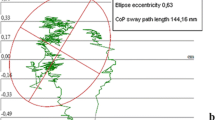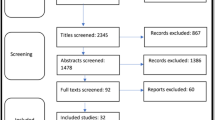Abstract
This study compared the effect of semantic and working memory tasks when each was concurrently performed with a voluntary balance task to evaluate the differences in the resulting cognitive-motor interference (CMI) between healthy aging and aging with stroke. Older stroke survivors (n = 10), older healthy (n = 10) and young adults (n = 10) performed the limits of stability, balance test under single task (ST) and dual task (DT) with two different cognitive tasks, word list generation (WLG) and counting backwards (CB). Cognitive ability was evaluated by recording the number of words and digits counted while sitting (ST) and during balance tasks (DT). The balance and cognitive costs were computed using [(ST–DT)/ST] × 100 for all the variables. Across groups, the balance cost was significantly higher for the older stroke survivors group in the CB condition than older healthy (p < 0.05) and young adult groups (p < 0.05) but was similar between these two groups for the WLG task. Similarly, the cognitive cost was significantly higher in older stroke survivors than in older healthy (p < 0.05) and young adults (p < 0.01) for both the cognitive tasks. The working memory task resulted in greater CMI than the semantic one, and this difference seemed to be most apparent in older stroke survivors. Young adults showed the least CMI, with a similar performance on the two memory tasks. On the other hand, healthy aging and stroke impact both semantic and working memory. Stroke-related cognitive deficits may further significantly decrease working memory function.


Similar content being viewed by others
Abbreviations
- CMI:
-
Cognitive-motor interference
- ST:
-
Single- task
- DT:
-
Dual- task
- CB:
-
Counting backward
- WLG:
-
Word list generation
- MMT:
-
Manual muscle testing
- SOMC:
-
Short Orientation–Memory–Concentration
- LOS:
-
Limits of stability
- MV:
-
Movement velocity
- N:
-
Number
- RT:
-
Response time
- BBS:
-
Berg balance scale
- TUG:
-
Timed up and go test
- MXE:
-
Maximum excursion
References
Abbott CA, Carrington AL, Ashe H et al (2002) The North-West diabetes foot care study: incidence of, and risk factors for, new diabetic foot ulceration in a community-based patient cohort. Diabet Med 19:377–384
Al-Yahya E, Dawes H, Smith L, Dennis A, Howells K, Cockburn J (2011) Cognitive motor interference while walking: a systematic review and meta-analysis. Neurosci Biobehav Rev 35:715–728. doi:10.1016/j.neubiorev.2010.08.008
Baier B, Karnath HO, Dieterich M, Birklein F, Heinze C, Muller NG (2010) Keeping memory clear and stable–the contribution of human basal ganglia and prefrontal cortex to working memory. J Neurosci 30:9788–9792. doi:10.1523/jneurosci.1513-10.2010
Bensoussan L, Viton JM, Schieppati M, Collado H, Milhe de Bovis V, Mesure S, Delarque A (2007) Changes in postural control in hemiplegic patients after stroke performing a dual task. Arch Phys Med Rehabil 88:1009–1015. doi:10.1016/j.apmr.2007.05.009
Bock O (2008) Dual-task costs while walking increase in old age for some, but not for other tasks: an experimental study of healthy young and elderly persons. J Neuroeng Rehabil 5:27. doi:10.1186/1743-0003-5-27
Boringa JB, Lazeron RH, Reuling IE et al (2001) The brief repeatable battery of neuropsychological tests: normative values allow application in multiple sclerosis clinical practice. Mult Scler 7:263–267
Boukadida A, Piotte F, Dehail P, Nadeau S (2015) Determinants of sit-to-stand tasks in individuals with hemiparesis post stroke: a review. Ann Phys Rehabil Med 58:167–172. doi:10.1016/j.rehab.2015.04.007
Brown LA, Shumway-Cook A, Woollacott MH (1999) Attentional demands and postural recovery: the effects of aging. J Gerontol A Biol Sci Med Sci 54:M165–M171
Carpenter PA, Just MA, Reichle ED (2000) Working memory and executive function: evidence from neuroimaging. Curr Opin Neurobiol 10:195–199
Cicerone KD, Dahlberg C, Kalmar K et al (2000) Evidence-based cognitive rehabilitation: recommendations for clinical practice. Arch Phys Med Rehabil 81:1596–1615. doi:10.1053/apmr.2000.19240
Cicerone KD, Dahlberg C, Malec JF et al (2005) Evidence-based cognitive rehabilitation: updated review of the literature from 1998 through 2002. Arch Phys Med Rehabil 86:1681–1692. doi:10.1016/j.apmr.2005.03.024
Davous P, Lamour Y, Debrand E, Rondot P (1987) A comparative evaluation of the short orientation memory concentration test of cognitive impairment. J Neurol Neurosurg Psychiatry 50:1312–1317
De Haart M, Geurts AC, Huidekoper SC, Fasotti L, van Limbeek J (2004) Recovery of standing balance in postacute stroke patients: a rehabilitation cohort study. Arch Phys Med Rehabil 85:886–895
Deviterne D, Gauchard GC, Jamet M, Vancon G, Perrin PP (2005) Added cognitive load through rotary auditory stimulation can improve the quality of postural control in the elderly. Brain Res Bull 64:487–492. doi:10.1016/j.brainresbull.2004.10.007
Di Fabio RP (1987) Lower extremity antagonist muscle response following standing perturbation in subjects with cerebrovascular disease. Brain Res 406:43–51
Dietz V, Berger W (1984) Interlimb coordination of posture in patients with spastic paresis. Impaired function of spinal reflexes. Brain 107(Pt 3):965–978
Doi T, Shimada H, Makizako H, Tsutsumimoto K, Uemura K, Anan Y, Suzuki T (2014) Cognitive function and gait speed under normal and dual-task walking among older adults with mild cognitive impairment. BMC Neurol 14:67. doi:10.1186/1471-2377-14-67
Fabre C, Chamari K, Mucci P, Masse-Biron J, Prefaut C (2002) Improvement of cognitive function by mental and/or individualized aerobic training in healthy elderly subjects. Int J Sports Med 23:415–421. doi:10.1055/s-2002-33735
Fischer BL, Gleason CE, Gangnon RE, Janczewski J, Shea T, Mahoney JE (2014) Declining cognition and falls: role of risky performance of everyday mobility activities. Phys Ther 94:355–362
Francis CA, Lenz AL, Lenhart RL, Thelen DG (2013) The modulation of forward propulsion, vertical support, and center of pressure by the plantarflexors during human walking. Gait Posture 38:993–997. doi:10.1016/j.gaitpost.2013.05.009
Hageman PA, Leibowitz JM, Blanke D (1995) Age and gender effects on postural control measures. Arch Phys Med Rehabil 76:961–965
Haggard P, Cockburn J, Cock J, Fordham C, Wade D (2000) Interference between gait and cognitive tasks in a rehabilitating neurological population. J Neurol Neurosurg Psychiatry 69:479–486
Hauer K, Pfisterer M, Weber C, Wezler N, Kliegel M, Oster P (2003) Cognitive impairment decreases postural control during dual tasks in geriatric patients with a history of severe falls. J Am Geriatr Soc 51:1638–1644
Hollands KL, Agnihotri D, Tyson SF (2014) Effects of dual task on turning ability in stroke survivors and older adults. Gait Posture 40:564–569. doi:10.1016/j.gaitpost.2014.06.019
Huxhold O, Li SC, Schmiedek F, Lindenberger U (2006) Dual-tasking postural control: aging and the effects of cognitive demand in conjunction with focus of attention. Brain Res Bull 69:294–305. doi:10.1016/j.brainresbull.2006.01.002
Hyndman D, Ashburn A, Yardley L, Stack E (2006) Interference between balance, gait and cognitive task performance among people with stroke living in the community. Disabil Rehabil 28:849–856. doi:10.1080/09638280500534994
Hyndman D, Pickering RM, Ashburn A (2009) Reduced sway during dual task balance performance among people with stroke at 6 and 12 months after discharge from hospital. Neurorehabil Neural Repair 23:847–854. doi:10.1177/1545968309338192
Jbabdi M, Boissy P, Hamel M (2008) Assessing control of postural stability in community-living older adults using performance-based limits of stability. BMC Geriatr 8:8. doi:10.1186/1471-2318-8-8
Koozekanani SH, Stockwell CW, McGhee RB, Firoozmand F (1980) On the role of dynamic models in quantitative posturography. IEEE Trans Biomed Eng 27:605–609. doi:10.1109/tbme.1980.326583
Lacour M, Bernard-Demanze L, Dumitrescu M (2008) Posture control, aging, and attention resources: models and posture-analysis methods. Neurophysiol Clin 38:411–421. doi:10.1016/j.neucli.2008.09.005
Laufer Y, Barak Y, Chemel I (2006) Age-related differences in the effect of a perceived threat to stability on postural control. J Gerontol A Biol Sci Med Sci 61:500–504
Laughton CA, Slavin M, Katdare K et al (2003) Aging, muscle activity, and balance control: physiologic changes associated with balance impairment. Gait Posture 18:101–108
Li KZ, Lindenberger U (2002) Relations between aging sensory/sensorimotor and cognitive functions. Neurosci Biobehav Rev 26:777–783
Li KZ, Lindenberger U, Freund AM, Baltes PB (2001) Walking while memorizing: age-related differences in compensatory behavior. Psychol Sci 12:230–237
Liu-Ambrose T, Pang MY, Eng JJ (2007) Executive function is independently associated with performances of balance and mobility in community-dwelling older adults after mild stroke: implications for falls prevention. Cerebrovasc Dis 23:203–210. doi:10.1159/000097642
Marigold DS, Eng JJ (2006) Altered timing of postural reflexes contributes to falling in persons with chronic stroke. Exp Brain Res 171:459–468. doi:10.1007/s00221-005-0293-6
Maslovat D, Chua R, Spencer HC, Forgaard CJ, Carlsen AN, Franks IM (2013) Evidence for a response preparation bottleneck during dual-task performance: effect of a startling acoustic stimulus on the psychological refractory period. Acta Psychol 144:481–487. doi:10.1016/j.actpsy.2013.08.005
Maylor EA, Wing AM (1996) Age differences in postural stability are increased by additional cognitive demands. J Gerontol B Psychol Sci Soc Sci 51:P143–P154
Maylor EA, Allison S, Wing AM (2001) Effects of spatial and nonspatial cognitive activity on postural stability. Br J Psychol 92(Part 2):319–338
McCollum G, Leen TK (1989) Form and exploration of mechanical stability limits in erect stance. J Mot Behav 21:225–244
Meyer DE, Kieras DE (1997) A computational theory of executive cognitive processes and multiple-task performance: Part 1. Basic mechanisms. Psychol Rev 104:3–65
Nashner LM, Peters JF (1990) Dynamic posturography in the diagnosis and management of dizziness and balance disorders. Neurol Clin 8:331–349
Park NW, Ingles JL (2001) Effectiveness of attention rehabilitation after an acquired brain injury: a meta-analysis. Neuropsychology 15:199–210
Pashler H (1989) Dissociations and dependencies between speed and accuracy: evidence for a two-component theory of divided attention in simple tasks. Cogn Psychol 21:469–514
Patel P, Bhatt T (2014) Task matters: influence of different cognitive tasks on cognitive-motor interference during dual-task walking in chronic stroke survivors. Top Stroke Rehabil 21:347–357. doi:10.1310/tsr2104-347
Patel P, Lamar M, Bhatt T (2014) Effect of type of cognitive task and walking speed on cognitive-motor interference during dual-task walking. Neuroscience 260:140–148. doi:10.1016/j.neuroscience.2013.12.016
Plummer P, Eskes G, Wallace S et al (2013) Cognitive-motor interference during functional mobility after stroke: state of the science and implications for future research. Arch Phys Med Rehabil 94:2565.e6–2574.e6. doi:10.1016/j.apmr.2013.08.002
Riley MA, Baker AA, Schmit JM (2003) Inverse relation between postural variability and difficulty of a concurrent short-term memory task. Brain Res Bull 62:191–195
Roerdink M, De Haart M, Daffertshofer A, Donker SF, Geurts ACH, Beek PJ (2006) Dynamical structure of center-of-pressure trajectories in patients recovering from stroke. Exp Brain Res 174:256–269
Roerdink M, Geurts AC, de Haart M, Beek PJ (2009) On the relative contribution of the paretic leg to the control of posture after stroke. Neurorehabil Neural Repair 23:267–274
Schaefer S (2014) The ecological approach to cognitive-motor dual-tasking: findings on the effects of expertise and age. Front Psychol 5:1167. doi:10.3389/fpsyg.2014.01167
Schaie KW, Willis SL (2010) The seattle longitudinal study of adult cognitive development. ISSBD Bull 57:24–29
Schwenk M, Zieschang T, Oster P, Hauer K (2010) Dual-task performances can be improved in patients with dementia: a randomized controlled trial. Neurology 74:1961–1968
Sommerfeld DK, Von Arbin MH (2004) The impact of somatosensory function on activity performance and length of hospital stay in geriatric patients with stroke. Clin Rehabil 18:149–155
Subramaniam S, Hui-Chan CWY, Bhatt T (2014) A cognitive-balance control training paradigm using wii fit to reduce fall risk in chronic stroke survivors. J Neurol Phys Ther 38:216–225. doi:10.1097/npt.0000000000000056
Vuillerme N, Nougier V (2004) Attentional demand for regulating postural sway: the effect of expertise in gymnastics. Brain Res Bull 63:161–165. doi:10.1016/j.brainresbull.2004.02.006
Wintz MN (1959) Variations in current manual muscle testing. Phys Ther Rev 39:466–475
Woollacott M, Shumway-Cook A (2002) Attention and the control of posture and gait: a review of an emerging area of research. Gait Posture 16:1–14
Acknowledgments
The authors thank Anisha Tailor for editing the manuscript. No commercial party having a direct financial interest in the research findings reported here has conferred or will confer a benefit on the authors or on any organization with which the authors are associated.
Author information
Authors and Affiliations
Corresponding author
Rights and permissions
About this article
Cite this article
Bhatt, T., Subramaniam, S. & Varghese, R. Examining interference of different cognitive tasks on voluntary balance control in aging and stroke. Exp Brain Res 234, 2575–2584 (2016). https://doi.org/10.1007/s00221-016-4662-0
Received:
Accepted:
Published:
Issue Date:
DOI: https://doi.org/10.1007/s00221-016-4662-0




